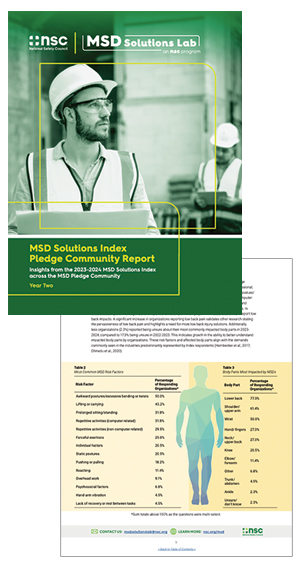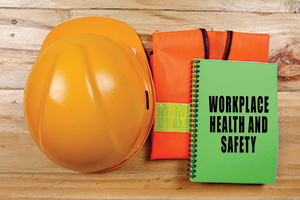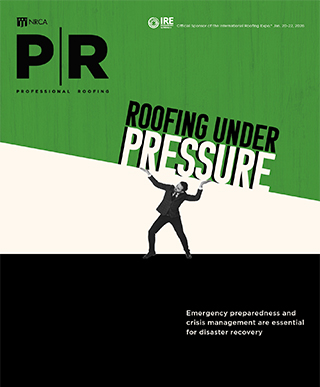Report shows improvements in MSD prevention

Multiple workplace programs aimed at preventing musculoskeletal disorders have achieved the highest rating within the National Safety Council’s MSD Solutions Index, according to a recent report from NSC.
The council’s second annual MSD Solutions Index Pledge Community Report explores areas in which organizations that have signed its MSD Pledge are strongest and what opportunities for improvement exist.
The report is based on survey responses from 44 MSD Pledge members from various industries who addressed questions from three pledge commitment subsections: risk reduction, safety culture, innovation and collaboration. The respondents received an overall index result, as well as the results of each subsection. Each corresponded to one of five MSD prevention maturity levels: novice, reactive, advancing, proactive and innovating.
According to the report, most respondents scored in the proactive (44.2%) or advancing (37.2%) categories; 11.6% of respondents were “innovating” in their MSD prevention efforts.
Findings from the report include:
- Eighty-eight percent of respondents have some form of MSD prevention or ergonomics program in place—up from 83% in the previous report.
- Seventy-six percent of the organizations share successful MSD prevention solutions at conferences or through external communications.
- At 50%, awkward postures/excessive bending or twists was the most common MSD risk factor reported, followed by lifting or carrying (43.2%), prolonged sitting/standing (31.8%) and computer-related repetitive activities (31.8%).
- The body parts most affected by MSDs are: lower back (77.3%), shoulder/upper arm (61.4%) and wrist (50%).
View the National Safety Council’s MSD Solutions Index
“This year’s report reflects the dedication of the MSD Pledge community to building safer workplaces and protecting workers’ health,” says Katherine Mendoza, senior director of workplace safety programs at NSC. “With the insights from the MSD Solutions Index, we see organizations are making significant strides and identifying critical areas for improvement, proving the MSD Pledge can drive real change in the safety and well-being of workers worldwide.”
Researchers to create construction safety toolkit

A collaborative research effort is underway to build a toolkit to help construction managers, supervisors and workers identify and address safety and health challenges unique to the industry, according to Safety+Health magazine.
The Collaborative Leadership for Safety and Health in Construction project is being led by researchers from the Colorado School of Public Health, Aurora, and the Center for Promotion of Health in the New England Workplace, Lowell, Mass. It is supported by CPWR–The Center for Construction Research and Training, the Centers for Disease Control and Prevention, and the National Institute for Occupational Safety and Health.
The five-year project is focused on the critical safety and mental health challenges in construction. Researchers expect the toolkit to foster a comprehensive, sustainable culture of safety and health by emphasizing collaboration between various levels of the workforce and, in turn, contribute to reduced injury rates and enhanced worker health and well-being.
Eight contractors will implement and use the toolkit as researchers evaluate the process. After the evaluation process, the toolkit will be disseminated via the Occupational Safety and Health Administration, along with labor unions, contractor associations, professional safety and health associations, and workers’ compensation insurers.
“The secret of our approach is the focus on both leadership commitment and workforce engagement,” Natalie Schwatka, project leader and assistant professor at the Centers for Health, Work & Environment at the Colorado School of Public Health, said in a press release. “This project is about creating a framework that gives both managers/supervisors and workers a more active role in the safety and well-being initiatives at their workplaces.”



